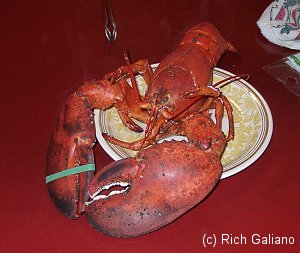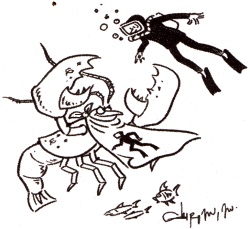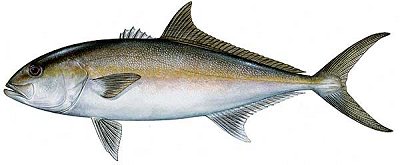Lobstering - Cooking Your Catch
Boiling

The number of lobsters to be boiled determines the minimum kettle size. The water should fill the pot one-half to not more than two-thirds full. Bring water to a rolling boil over high heat. Place lobsters headfirst into the pot, completely submerging them.
Cover the pot tightly and return to a boil as quickly as possible. When water boils, begin counting the time. Regulate the heat to prevent water from boiling over, but be sure to keep the liquid boiling throughout the cooking time.
Boil a lobster for 10 minutes per pound, for the first pound. Add 3 minutes per pound for each additional pound thereafter. For example, a 2-pound lobster should boil for 13 minutes and a 1 1/2 pound lobster should boil for 11 1/2 minutes.
Steaming
Pour 2 inches of seawater into a pot large enough to comfortably hold the lobsters. Some cooks also place a steaming rack large enough to hold the lobsters above the water, in the bottom. Bring water to a rolling boil over high heat. Place lobsters in the pot, cover tightly, return to a boil as quickly as possible and start counting the time.
Steam a lobster for 13 minutes per pound, for the first pound. Add 3 minutes per pound for each additional pound thereafter. For example, a 2-pound lobster should steam for 16 minutes and a 1-1/2 pound lobster should steam for 14-1/2 minutes.
Note: These times are for hard-shelled lobsters; if cooking new-shell lobsters, reduce boiling or steaming time by three minutes. When the antennae pull out easily, the lobsters are done.
Grilling
Split the lobsters in half lengthwise: place each lobster on its back and insert the point of a large French knife into the head just below the eyes. Bring the knife down through the tail, making sure to cut just through the meat and to leave the shell connected. Lay the lobster open, leaving the two halves slightly attached.
Pull off the claws and legs from the lobsters and crack them slightly with the knife handle. You just want to fracture the shell a bit here. Place the claws and legs on the grill over medium-low heat and cover with a pie pan. Cook them for 5 to 7 minutes per side.
Sprinkle the lobster bodies with salt and pepper to taste and place them flesh-side down on the grill over medium heat. Grill for 8 to 10 minutes. You don't need to turn them. Check to see if they are done by removing the tail from the shell of one of the lobsters. The exposed meat should be completely opaque.
In my opinion, grilling is the best way to prepare lobster. The meat comes out somewhat drier and more flavorful than if boiled or steamed, and there are far more possibilities in seasoning, stuffing, and other recipes. After splitting, try filling the cleaned body cavity and tail with crabmeat stuffing, or whatever you like.
Serving
Serve with melted butter, lemon halves, and nut-crackers if you have them. If not, use a hammer for the claws. For boiled or steamed lobsters, break the flippers off the tail and push the meat out with a fork. In Maine, it is common to eat the green stuff ( "tomalley" - the liver or hepatopancreas ) but with New Jersey lobsters it is safer not to, since that organ tends to accumulate toxic pollutants. Make sure you have paper towels handy - lobsters are a messy meal. Lobster meat may be frozen after cooking, but freezing uncooked lobster parts causes the meat to stick to the shell.



